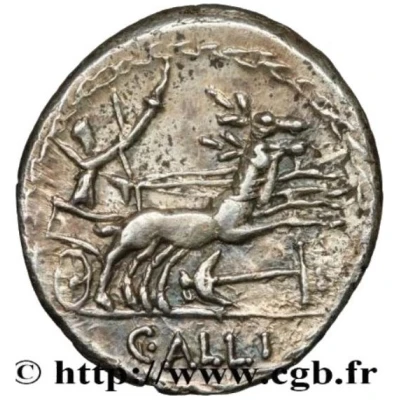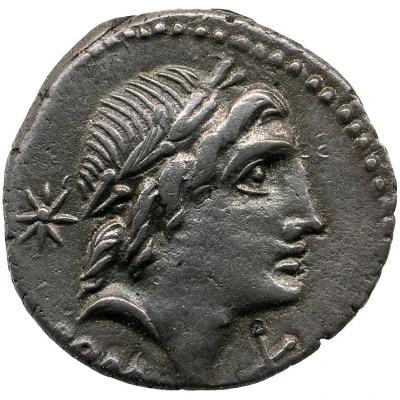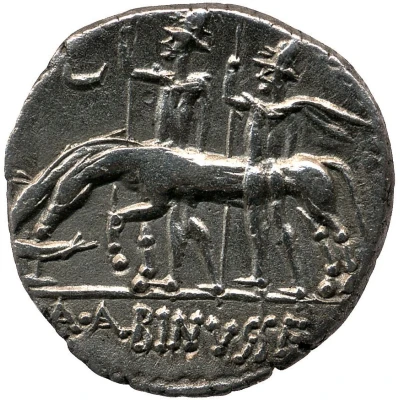


© CGB
Denarius Aelia: Caius Allius Bala, C•ALLI / BALA 92 BC
92 BC year| Silver | 3.91 g | 16.5 mm |
| Issuer | Rome › Roman Republic (509 BC - 27 BC) |
|---|---|
| Period | Republic (509 BC - 27 BC) |
| Type | Standard circulation coin |
| Year | 92 BC |
| Value | Denarius (1) |
| Currency | Denarius of 16 Asses (141 – 27 BC) |
| Composition | Silver |
| Weight | 3.91 g |
| Diameter | 16.5 mm |
| Shape | Round (irregular) |
| Technique | Hammered |
| Orientation | Variable alignment ↺ |
| Demonetized | Yes |
| Updated | 2024-10-06 |
| Numista | N#231622 |
|---|---|
| Rarity index | 91% |
Reverse
Diana in biga of stags, right, holding sceptre and reins in left hand and torch in right hand, with quiver over shoulder. Laurel-wreath border.
Script: Latin
Lettering: C•ALLI
Comment
Crawford's estimate for this type is 120 right-hand corners and 133 reverse corners. This denarius appears to be rarer than general catalogs suggest. Each letter of the right is associated with a symbol. Twenty-one letters from A to V are associated with the grasshopper, all listed in the Cabinet des médailles of the BnF.CGB
The various possible obverse letters are as follows:
A: (Photo credit: British Museum)
B: (Photo credit: CGB)
C: (Photo credit: BNF Gallica)
D: (Photo credit: BNF Gallica)
E: (Photo credit: BNF Gallica)
F : (Photo credit: CGB)
G: (Photo credit: BNF Gallica)
H: (Photo credit: BNF Gallica)
I: (Photo credit: BNF Gallica)
K: (Photo credit: BNF Gallica)
L: (Photo credit: BNF Gallica)
M: (Photo credit: BNF Gallica)
N: (Photo credit: BNF Gallica)
O: (Photo credit: Fitzwilliam Museum)
P: (Photo credit: BNF Gallica)
Q: (Photo credit: BNF Gallica)
R : (Photo credit: BNF Gallica)
S: (Photo credit: BNF Gallica)
T: (Photo credit: BNF Gallica)
V: (Photo credit: BNF Gallica)
X: (Photo credit: BNF Gallica)
No letter : (Photo credit: BNF Gallica)
Each letter on the obverse has a design associated with it on the reverse, as illustrated below. The same designs are sometimes used for different letters:
Anchor (pointing to the right) : (Photo credit: British Museum)
Anchor (point to the left): (Photo credit: CGB)
Caduceus : (Photo credit: BNF Gallica)
Duck : (Photo Credit: CGB)
Quiver : (Photo Credit: BNF Gallica)
Sacrificial knife : (Photo credit: BNF Gallica)
Crab : (Photo credit: BNF Gallica)
Dolphin : (Photo credit: BNF Gallica)
Crayfish : (Photo credit: British Museum)
Épi : (Photo Credit: BNF Gallica)
Grenouille : (Photo credit: BNF Gallica)
Griffin: (Photo credit: BNF Gallica)
Fly : (Photo Credit: BNF Gallica)
Grasshopper : (Photo credit: BNF Galica)
Ploughshare : (Photo credit: BNF Galica)
Ram's head: (Photo credit: BNF Galica)
Turtle : (Photo credit: BNF Galica)
Trident : (Photo credit: BNF Galica)
The engravings of these letters and symbols vary in style and orientation, as well as in size. This is due to the fact that, at the time, the corner was made by hand.
Not all authors agree on the dating of this Denarius, as it is known only from the coins it minted. D.Sear, Crawford and H.A. Seaby date it -92, Babelon -90 and Grueber c. -89. 3 authors are of the same opinion for -92, so it is preferable to date this coin to this year.
Interesting fact
The Denarius coin , which was minted in 92 BC during the Roman Republic, features an image of the Roman goddess Libertas on the obverse (front side), which symbolizes freedom and liberty. This is interesting because the Roman Republic was known for its emphasis on individual liberties and the idea of freedom, which was a core value of the Roman society at the time. The coin's design serves as a reflection of this cultural significance and highlights the importance of liberty in Roman society.



